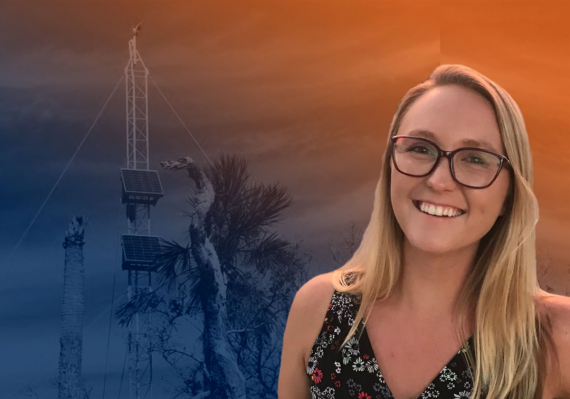Boats, yachts and other commercial and recreational ships are among the biggest threats to maintaining coastal habitats along in Florida, according to Christine Angelini, Ph.D., associate professor in the Engineering School of Sustainable Infrastructure and Environment (ESSIE). There has been a significant decrease in oyster reef and coastal wetlands due to erosion from boat traffic, especially along the boat highway that spans nearly 3,000 miles of the US Atlantic and Gulf coasts: the Intracoastal Waterway.
The Coastal Ecosystem Dynamics (CESD) research group, led by Coastal and Oceanographic Engineering graduate student Lauren Brisley, created an autonomous solar-powered video monitoring station to examine the relationships and address concerns among boats, erosion of coastal habitats and wildlife activity in a stretch of the Intracoastal Waterway.
“We want to get an understanding of how the energy produced by boat traffic may impact coastal ecosystems and wildlife habitats,” Brisley said.
Brisley worked with CESD research technician Todd Van Natta to develop the 30-foot monitoring system by connecting a weatherproof security camera to two solar panels and repurposed hurricane monitoring towers, provided by the UF Hurricane Research group within ESSIE.
“We’re monitoring all types of traffic through the area, size and speed of the boats, and the sizes of waves the boats are producing,” Brisley said.
The monitoring system overlooks the intersection of the Intracoastal Waterway and the Guana River in Ponte Vedra, FL. The research team can detect commercial and recreational boating activity, changes in coastal habitat area, and pattern in birds, dolphins, turtles and manatees.
“We wanted to target this particular area because it is an estuarian, where there’s a junction of the salty Intracoastal, meeting the Guana River, a fresh water river,” Brisley said. “That interaction with fresh and salt water produces the environment for specific ecosystems that are important for primary production for coastal ecosystems as a whole.”
Brisley and Angelini are partnering with the Guana Tolomato Matanzas National Estuarine Research Reserve Research Reserve by enrolling the Reserve’s citizen scientist volunteers to download and pre-process video footage.
They are also partnering with the U.S. Naval Research Laboratory and Alex Sheremet, Ph.D., professor in Coastal and Oceanographic Engineering, to develop new techniques for data analysis on video footage by using machine learning and to identify the types of boating traffic most damaging to coastal habitats.
Brisley credits Angelini for her guidance with this research project.
“Dr. Angelini asked me if I wanted to do a little bit of video monitoring in the Intracoastal Waterway,” Brisley said. “She gave me the opportunity to see if this was something I’d be interested in and then she let me run with it.”
The video monitoring station is one of many initiatives stemmed from iCoast toward researching and creating novel technologies to protect Florida’s coastline from environmental change, contaminant release and infrastructure failure. The iCoast project was created to research and address coastline vulnerabilities throughout Florida.
Angelini stated that the University of Florida is on the frontlines of conducting innovative research on addressing coastal and environmental needs by supporting the iCoast projects.
“UF is breathing tremendous life into this project,” Angelini said. “For the vitality of Florida, we have to understand what is going on in the coastal zone.”
